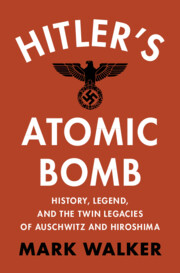Book contents
- Hitler’s Atomic Bomb
- Hitler’s Atomic Bomb
- Copyright page
- Dedication
- Contents
- Figures
- Preface
- Acknowledgments
- Abbreviations
- Introduction
- Part I The Bomb
- 1 Farm Hall
- 2 Nuclear Fission
- 3 Lightning War
- 4 Selling Uranium
- 5 Total War
- 6 The War is Lost
- Part II Living with the Bomb
- Glossary
- Notes
- Archives
- Bibliography
- Index
3 - Lightning War
from Part I - The Bomb
Published online by Cambridge University Press: 18 July 2024
- Hitler’s Atomic Bomb
- Hitler’s Atomic Bomb
- Copyright page
- Dedication
- Contents
- Figures
- Preface
- Acknowledgments
- Abbreviations
- Introduction
- Part I The Bomb
- 1 Farm Hall
- 2 Nuclear Fission
- 3 Lightning War
- 4 Selling Uranium
- 5 Total War
- 6 The War is Lost
- Part II Living with the Bomb
- Glossary
- Notes
- Archives
- Bibliography
- Index
Summary
When Germany invaded Poland, German officials set up a research project into the possible military uses of uranium fission. A nuclear reactor, what the Germans called a “uranium machine,” needed a moderator to slow down neutrons. Water, heavy water, and pure carbon in the form of graphite were all considered, but water would need uranium in which the percentage of isotope 235 is increased, and it did not appear feasible for German industry to produce graphite with sufficient purity. Paul Harteck and his collaborator Wilhelm Groth first tried to separate the uranium isotopes with a separation tube. When this failed, the two physical chemists turned to centrifuges. Scientists in Berlin, Heidelberg, and Leipzig began experiments on the behavior of materials when bombarded with neutrons and on model nuclear reactors. At first the materials needed were scarce but Germany captured the Norsk Hydro in Norway, the largest heavy water producer in the world, and the defeat of Belgium brought with it tons of uranium compounds. From the start of the war through to the autumn of 1941, this research had low priority and made modest progress. At this stage of the war, powerful new weapons did not appear needed.
Keywords
- Type
- Chapter
- Information
- Hitler's Atomic BombHistory, Legend, and the Twin Legacies of Auschwitz and Hiroshima, pp. 21 - 47Publisher: Cambridge University PressPrint publication year: 2024

